Abstract
Most vertebrates contain sets of gene sequences (virogenes) which are an integral part of the chromosomal DNA and which can code, in some instances, for the production of Type C RNA tumor viruses. These genes are transmitted from parent to progeny along with other cellular genes, and their activation from a normally reressed state may be part of the mechanism by which RNA tumor viruses produce cancer. Isolates of endogenous genetically transmitted baboon Type C viruses are morphologically and biochemically related to other mammalian Type C viruses but can clearly be distinguished from the other groups (mouse, rat, cat, etc.) by immunologic and nucleic acid hybridization criteria. Within the primates, Type C viral gene sequences have evolved as the species have evolved, with virogenes from the most closely related genera and families showing the most sequence homology; all higher primate, including man, however, do have detectable virogene sequences in their normal tissues. Type C viruses have also been transferred under natural conditions between species only remotely related phylogenetically. The results show three clear examples where viral genes from one group of animals have become incorporated into the germ line of genetically distant groups of animals (inheritance of acquired genes). Infectious Type C viruses of primates, distinct from the endogenous primate virus group, have also been isolated (woolly monkey and gibbon isolates) and can be shown to produce tumors in other primates. Related viral information (nucleic acid sequences, enzymes, and antigens) have been reported in human tumors. The significance of infectious and/or genetically transmitted viruses in naturally occurring cancer is a major focus of current research. The presence of genetically transmitted viral genes in so many vertebrate species and the evidence that they have been conserved in several distinct vertebrate lineages suggests that they may provide some normal function(s) advantageous to the species carrying them and that their potential to cause cancers is a pathologic manifestation of normal, as yet undefined, physiologic processes.
Full text
PDF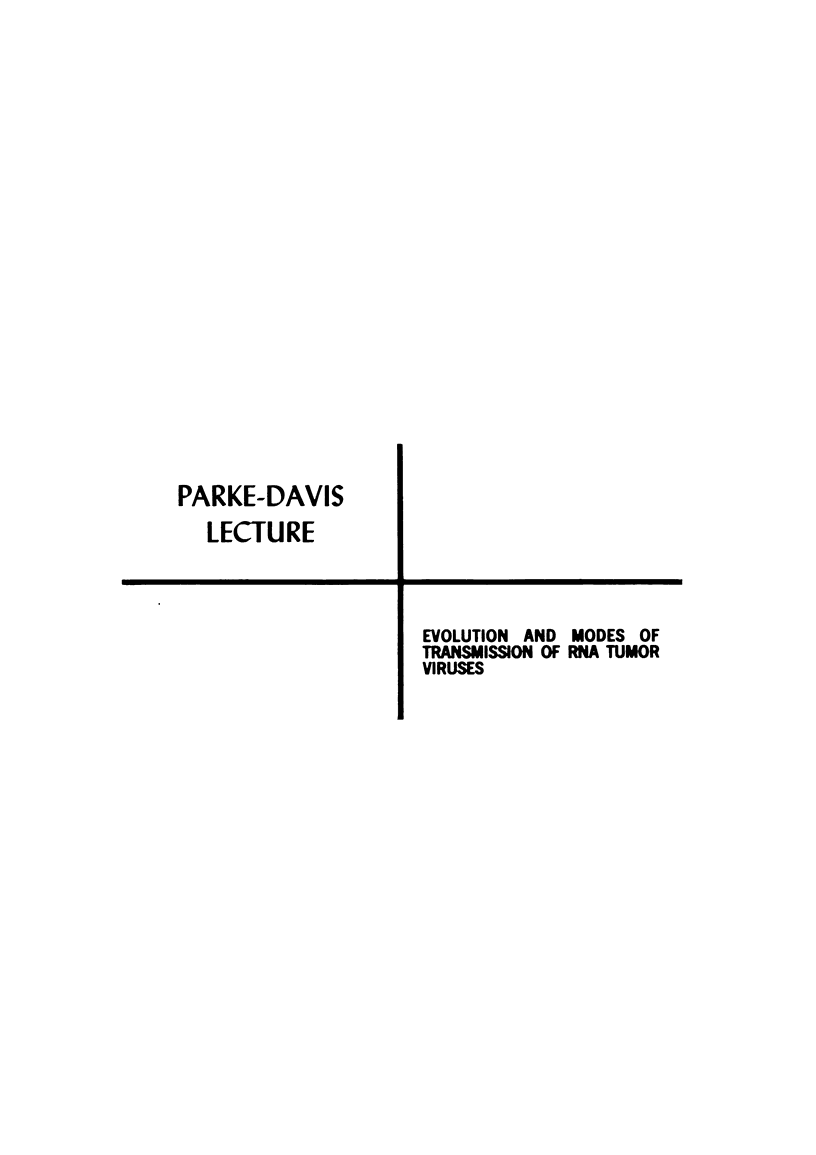
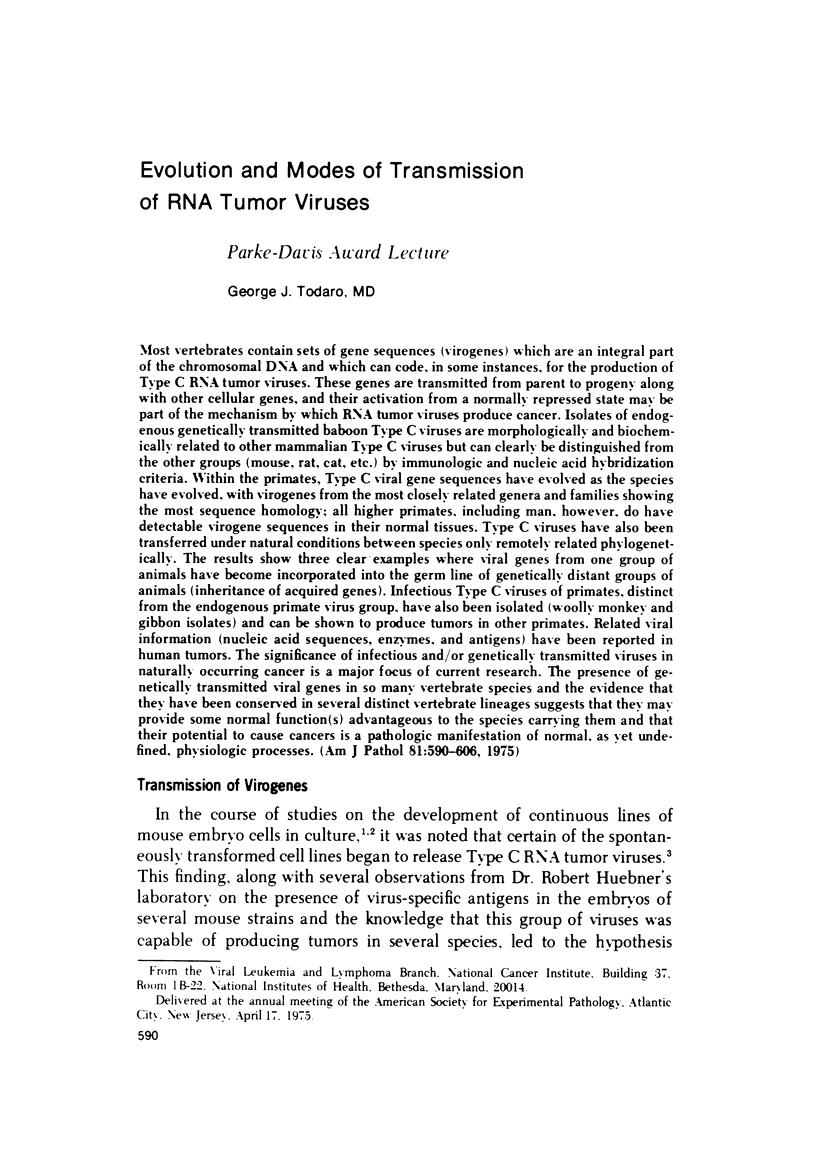
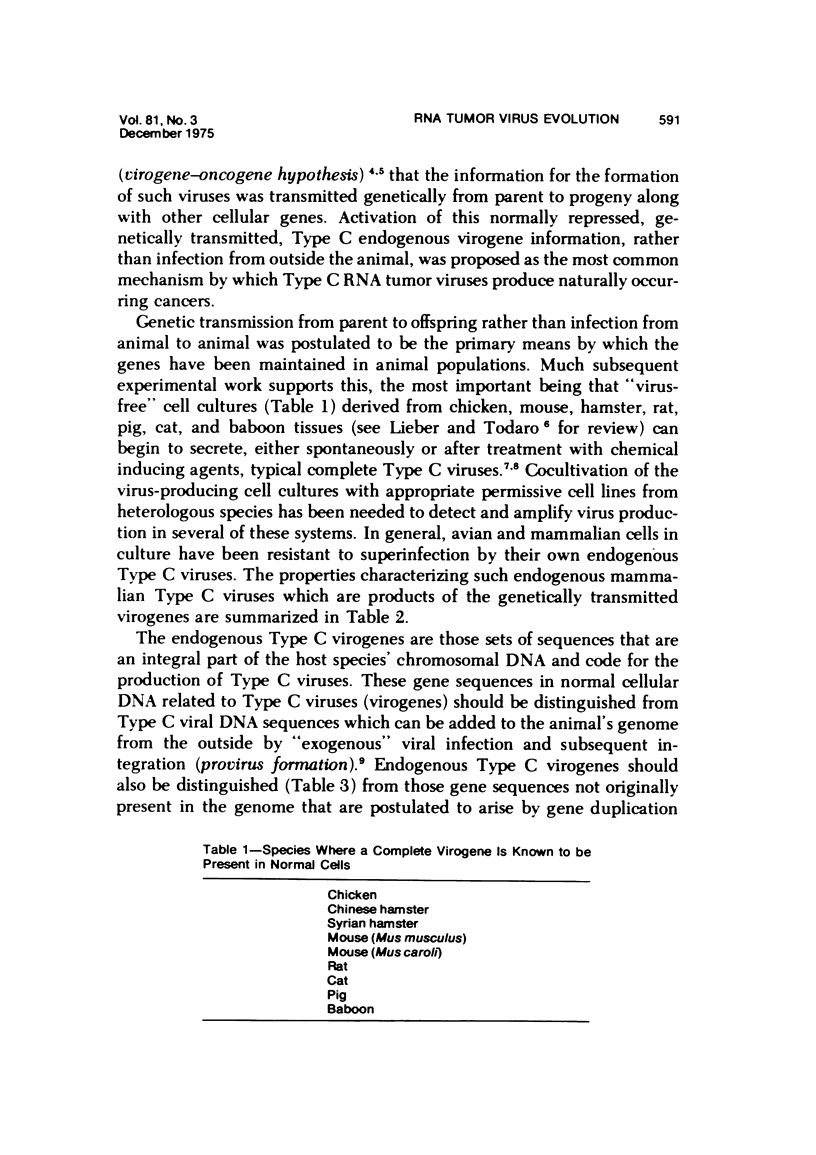
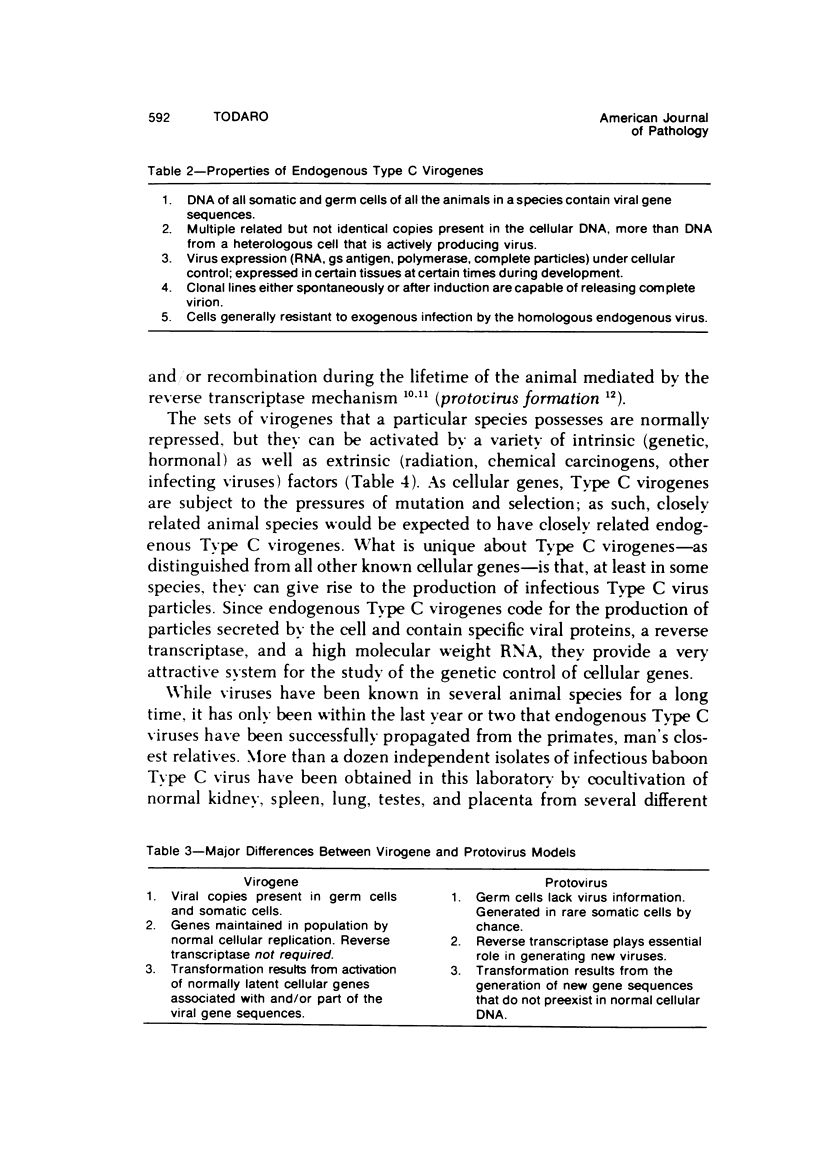
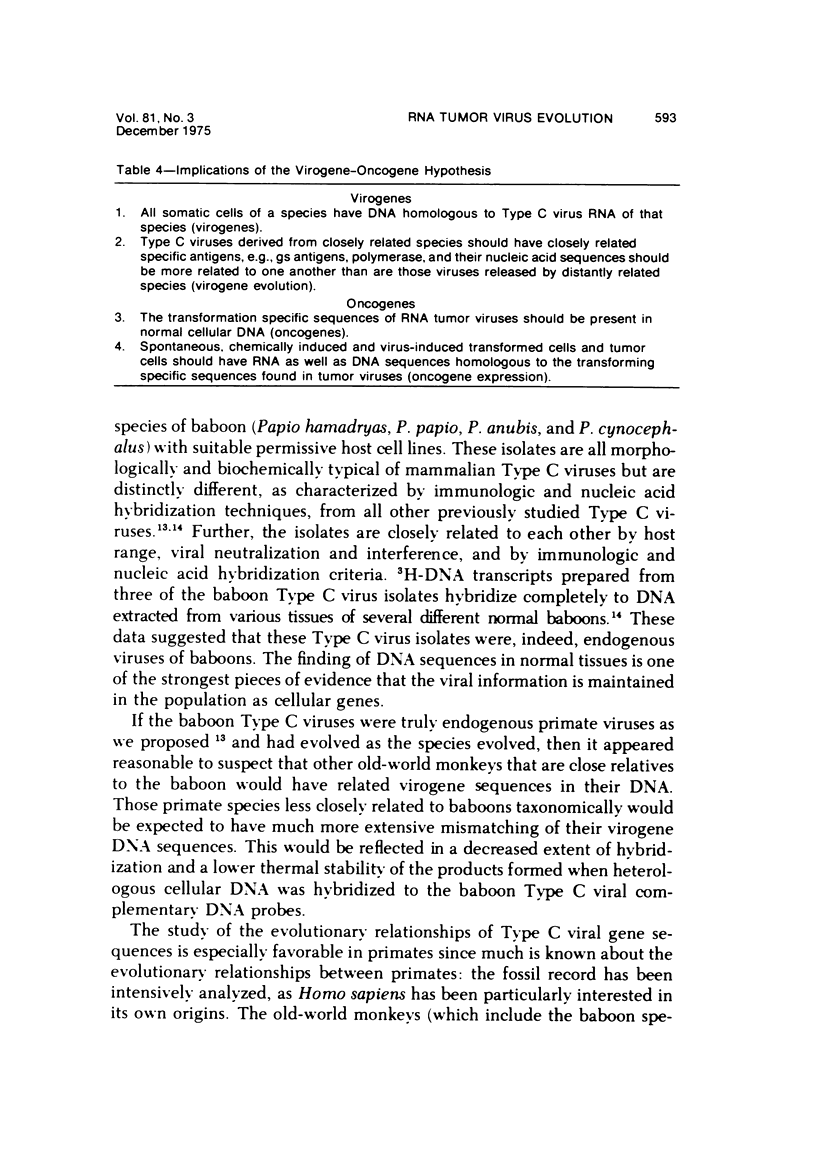
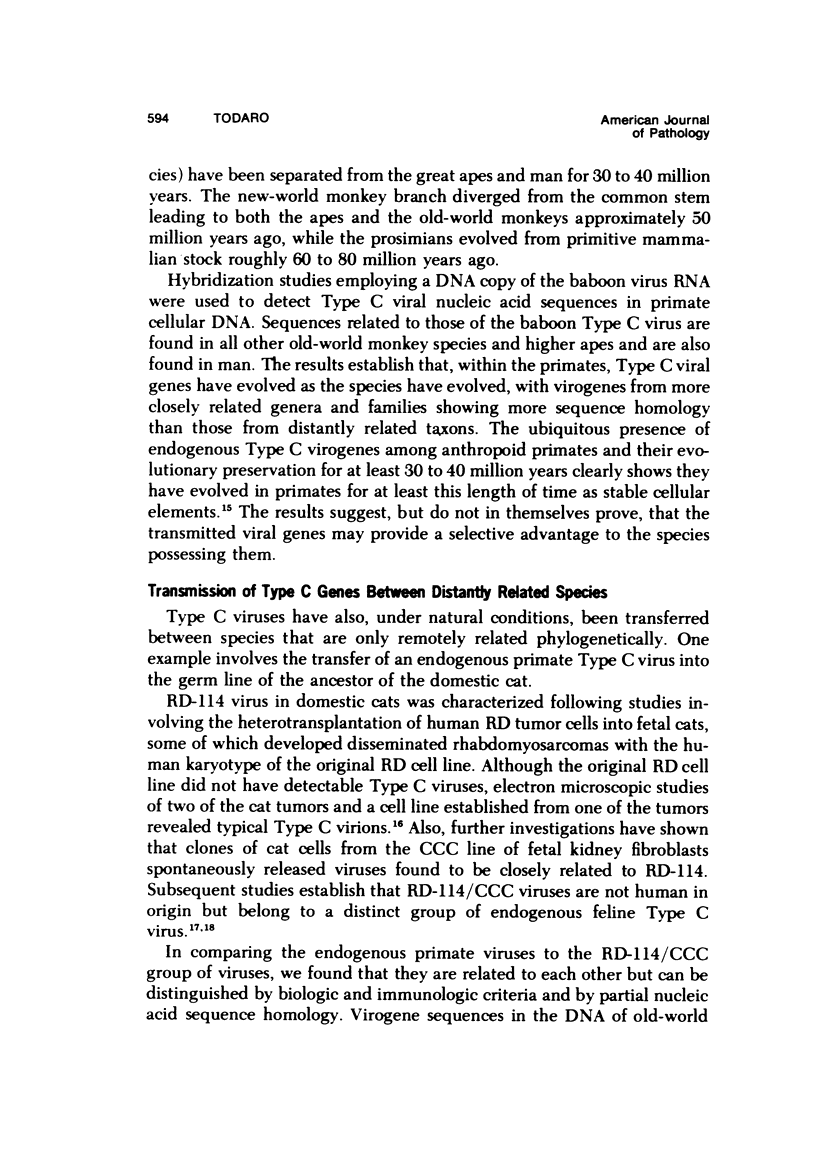

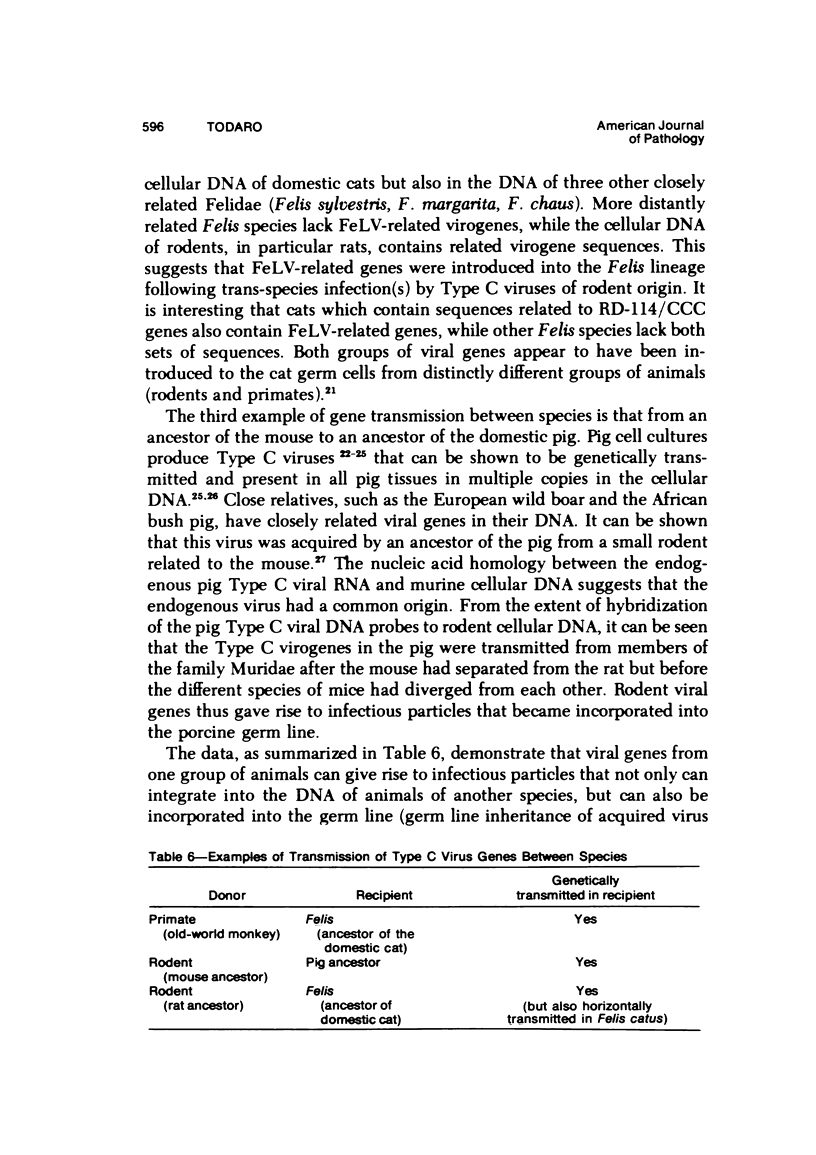
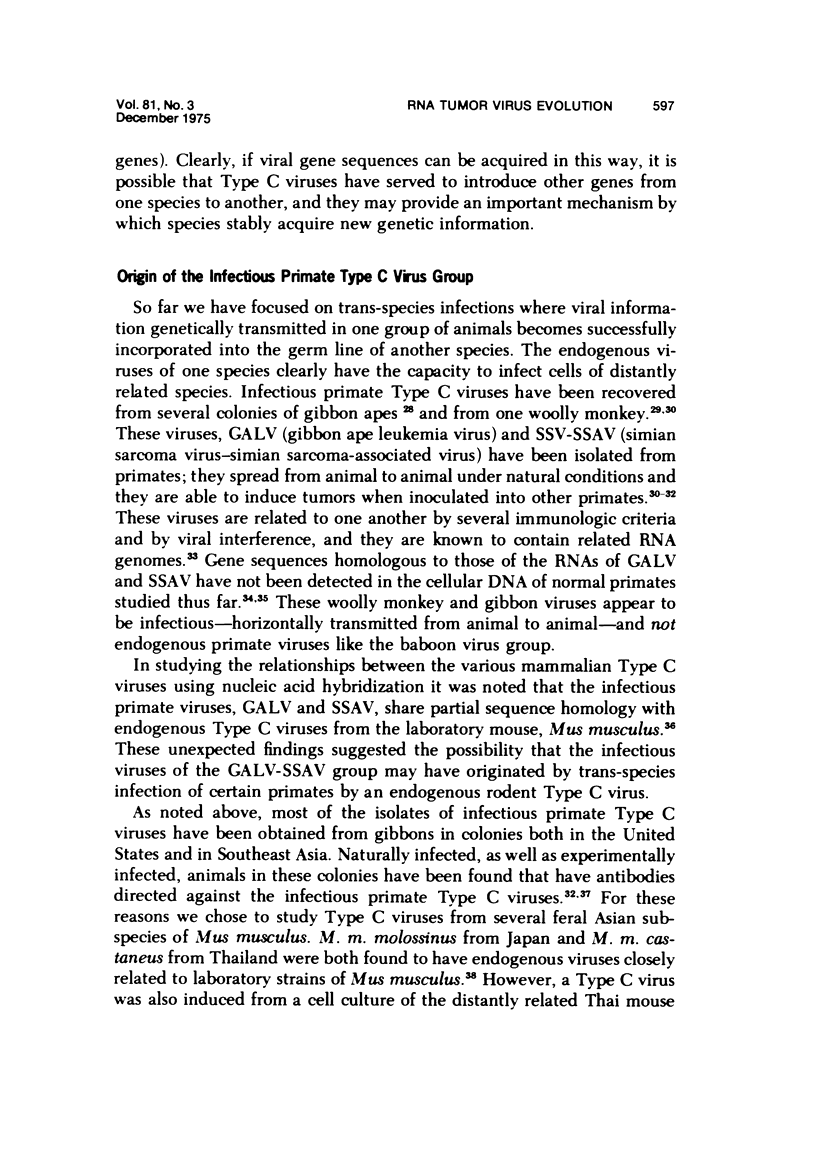
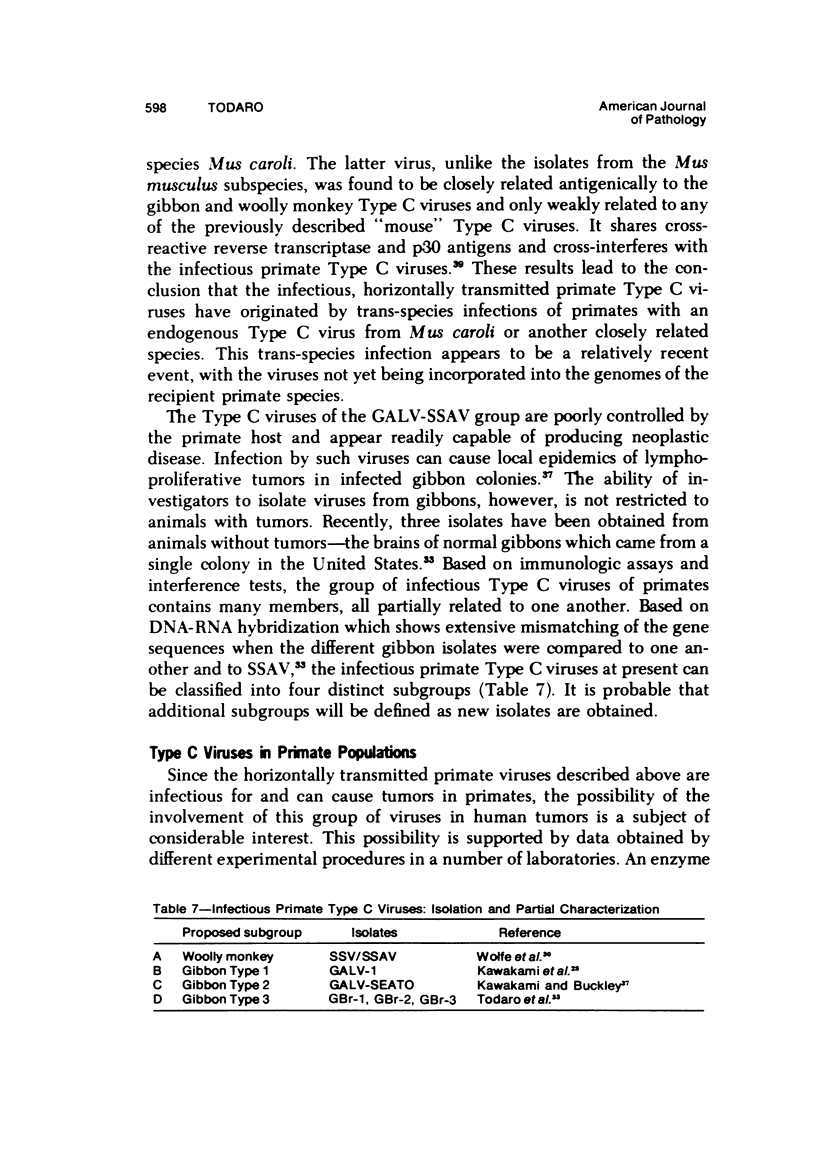
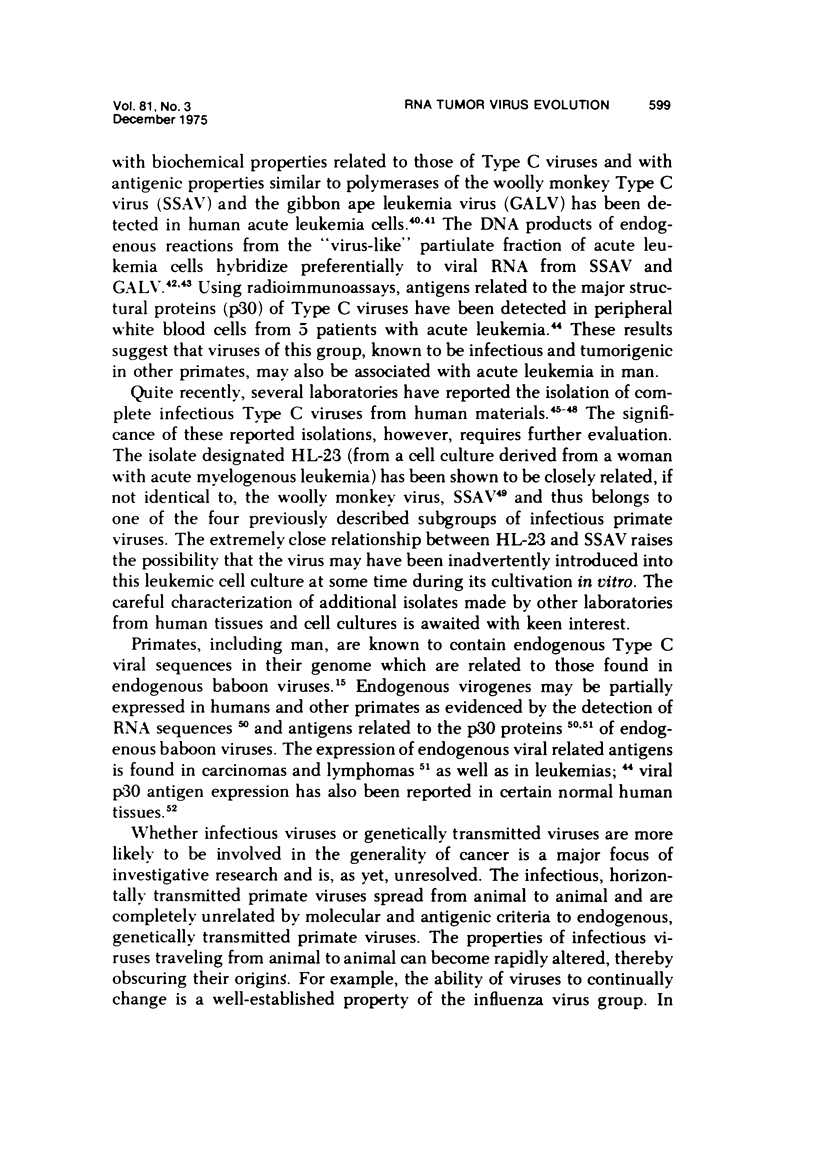

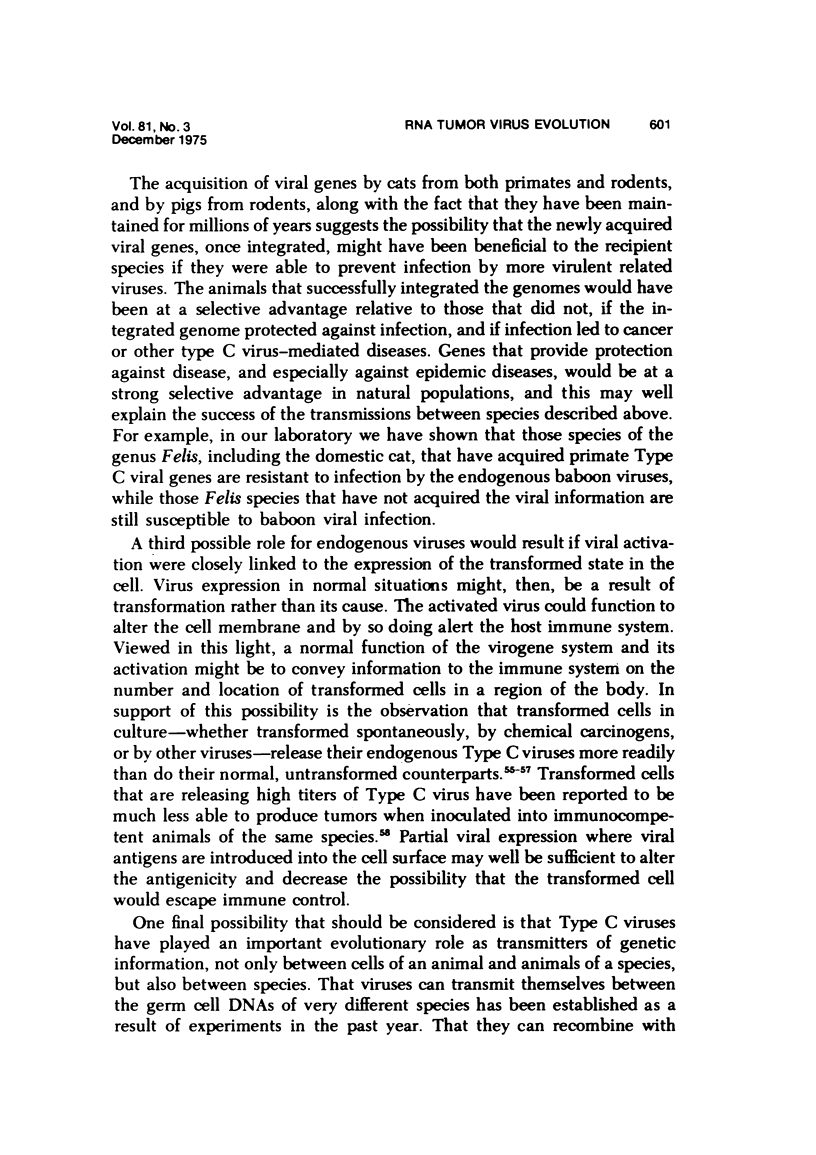
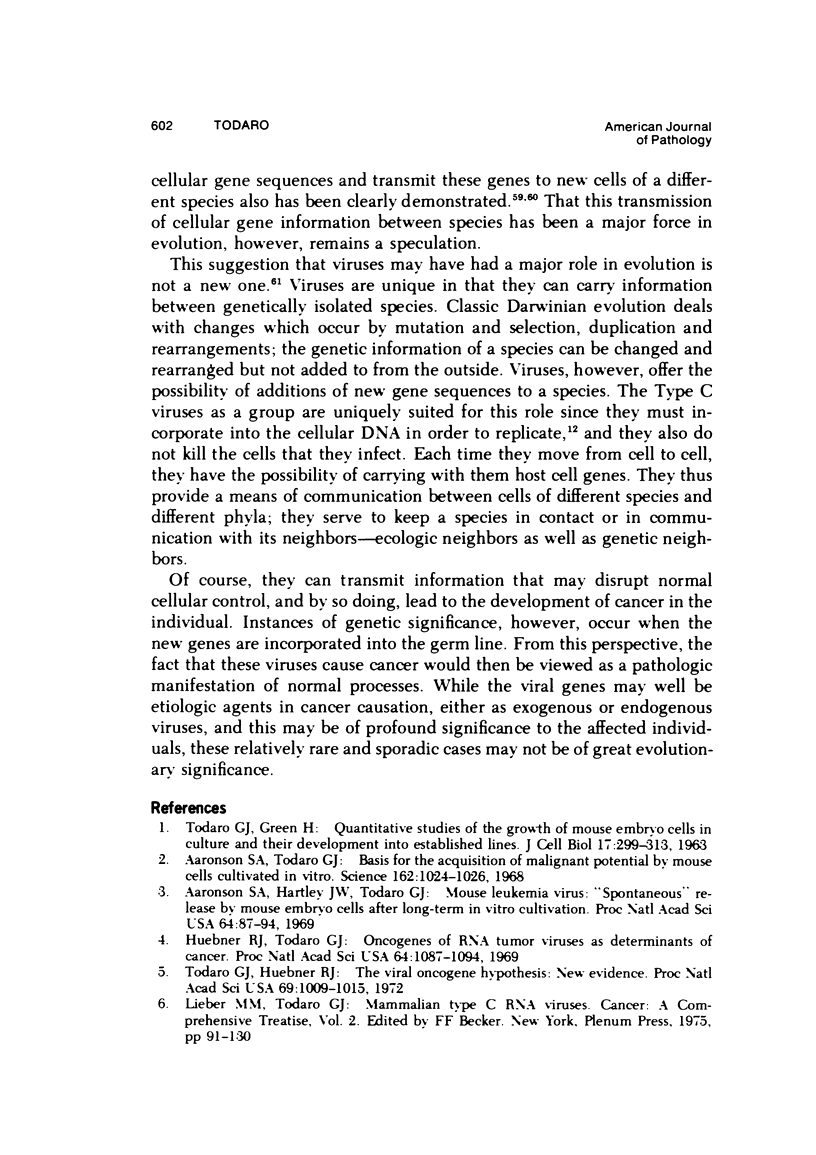
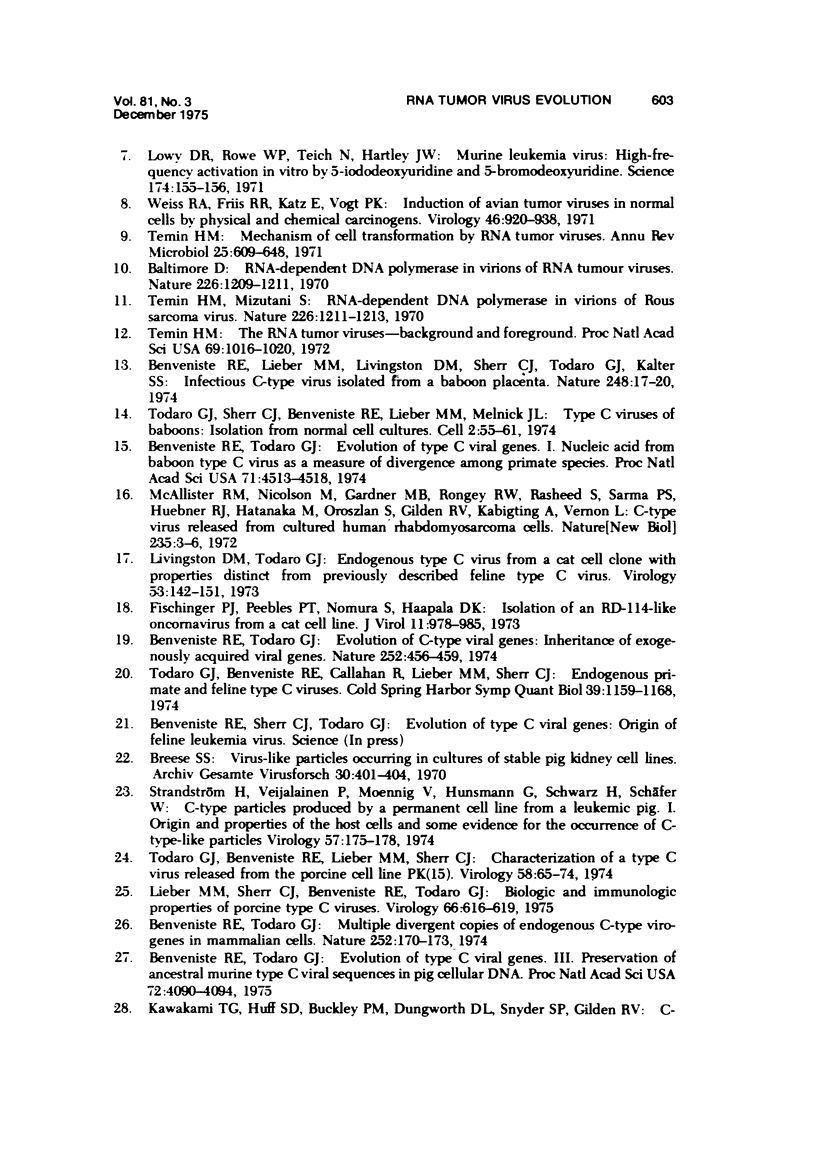
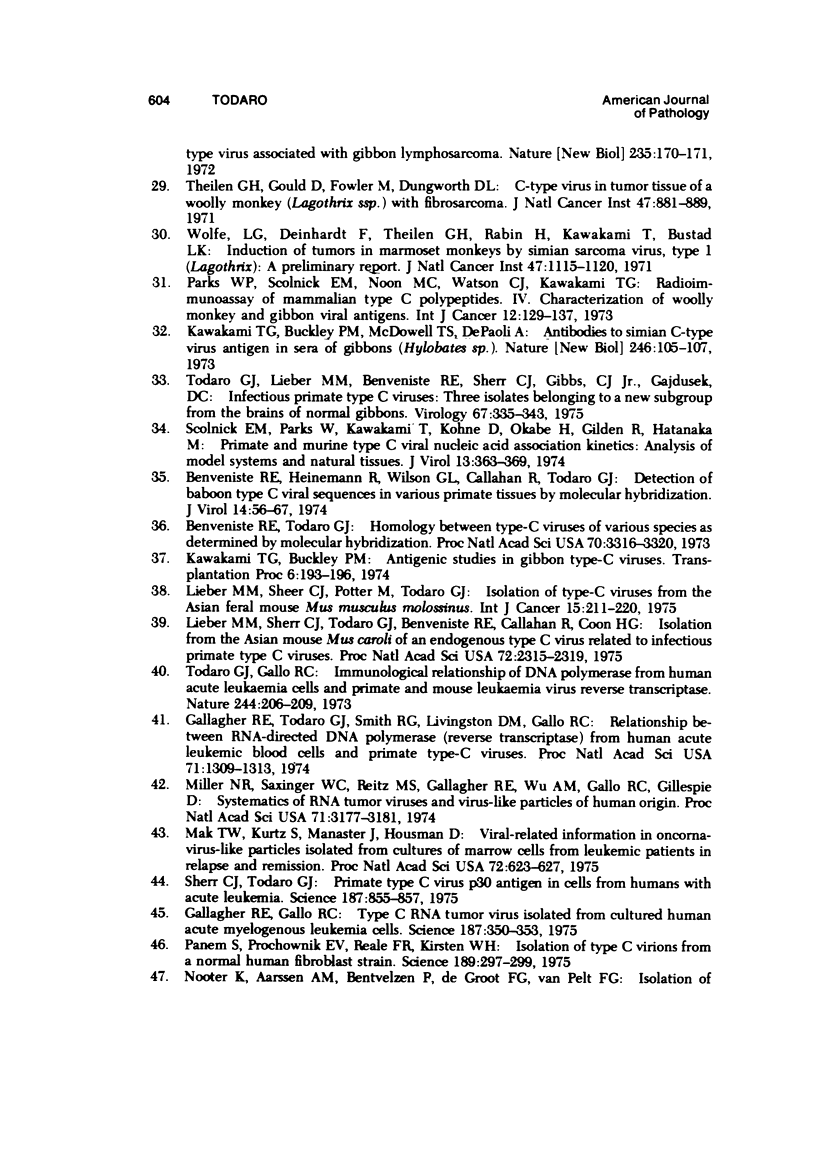
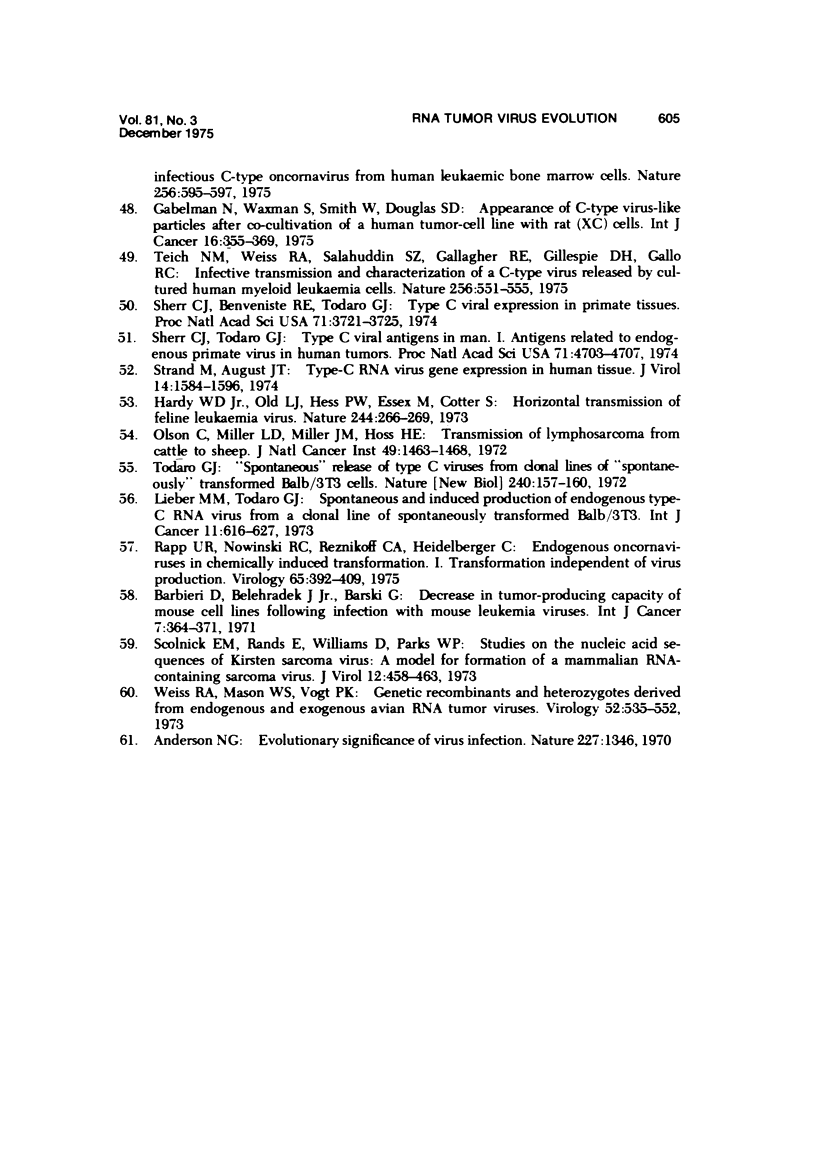
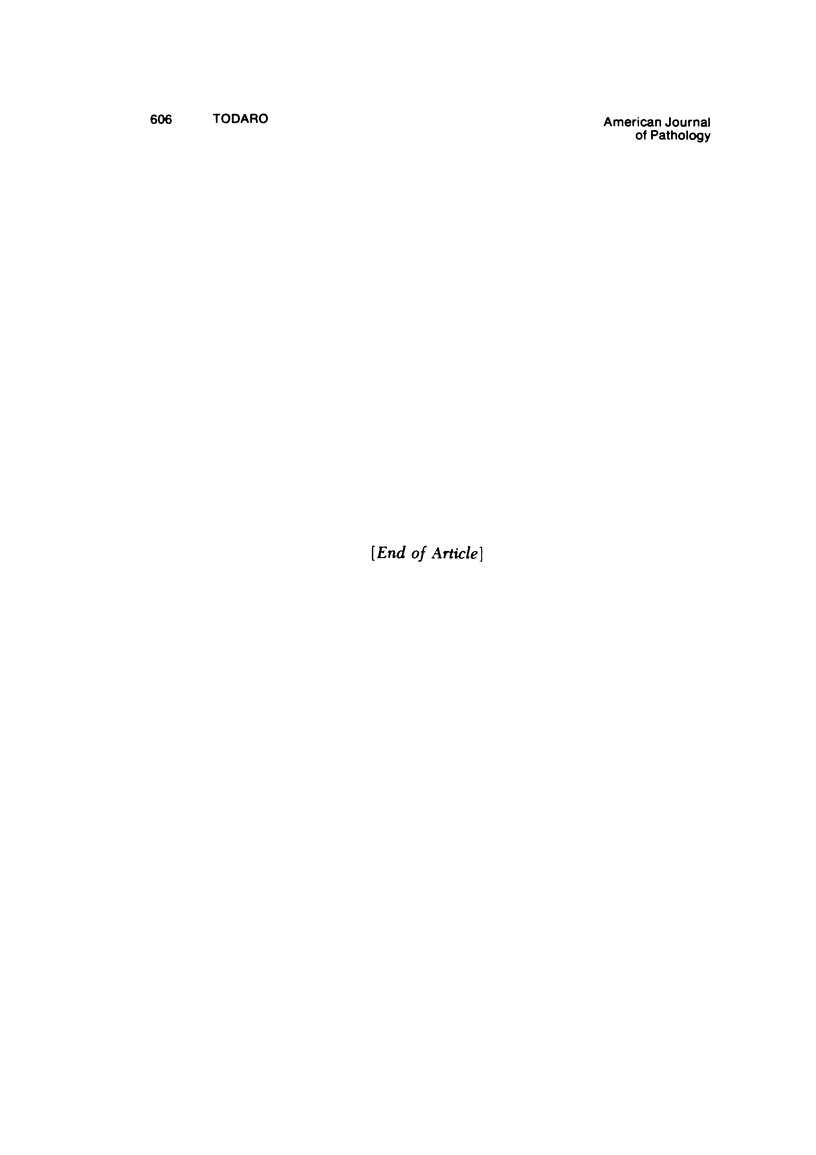
Selected References
These references are in PubMed. This may not be the complete list of references from this article.
- Aaronson S. A., Hartley J. W., Todaro G. J. Mouse leukemia virus: "spontaneous" release by mouse embryo cells after long-term in vitro cultivation. Proc Natl Acad Sci U S A. 1969 Sep;64(1):87–94. doi: 10.1073/pnas.64.1.87. [DOI] [PMC free article] [PubMed] [Google Scholar]
- Aaronson S. A., Todaro G. J. Basis for the acquisition of malignant potential by mouse cells cultivated in vitro. Science. 1968 Nov 29;162(3857):1024–1026. doi: 10.1126/science.162.3857.1024. [DOI] [PubMed] [Google Scholar]
- Anderson N. G. Evolutionary significance of virus infection. Nature. 1970 Sep 26;227(5265):1346–1347. doi: 10.1038/2271346a0. [DOI] [PubMed] [Google Scholar]
- Baltimore D. RNA-dependent DNA polymerase in virions of RNA tumour viruses. Nature. 1970 Jun 27;226(5252):1209–1211. doi: 10.1038/2261209a0. [DOI] [PubMed] [Google Scholar]
- Barbieri D., Belehradek J., Jr, Barski G. Decrease in tumor-producing capacity of mouse cell lines following infection with mouse leukemia viruses. Int J Cancer. 1971 Mar 15;7(2):364–371. doi: 10.1002/ijc.2910070222. [DOI] [PubMed] [Google Scholar]
- Benveniste R. E., Heinemann R., Wilson G. L., Callahan R., Todaro G. J. Detection of baboon type C viral sequences in various primate tissues by molecular hybridization. J Virol. 1974 Jul;14(1):56–67. doi: 10.1128/jvi.14.1.56-67.1974. [DOI] [PMC free article] [PubMed] [Google Scholar]
- Benveniste R. E., Lieber M. M., Livingston D. M., Sherr C. J., Todaro G. J., Kalter S. S. Infectious C-type virus isolated from a baboon placenta. Nature. 1974 Mar 1;248(5443):17–20. doi: 10.1038/248017a0. [DOI] [PubMed] [Google Scholar]
- Benveniste R. E., Todaro G. J. Evolution of C-type viral genes: inheritance of exogenously acquired viral genes. Nature. 1974 Dec 6;252(5483):456–459. doi: 10.1038/252456a0. [DOI] [PubMed] [Google Scholar]
- Benveniste R. E., Todaro G. J. Evolution of type C viral genes: I. Nucleic acid from baboon type C virus as a measure of divergence among primate species. Proc Natl Acad Sci U S A. 1974 Nov;71(11):4513–4518. doi: 10.1073/pnas.71.11.4513. [DOI] [PMC free article] [PubMed] [Google Scholar]
- Benveniste R. E., Todaro G. J. Evolution of type C viral genes: preservation of ancestral murine type C viral sequences in pig cellular DNA. Proc Natl Acad Sci U S A. 1975 Oct;72(10):4090–4094. doi: 10.1073/pnas.72.10.4090. [DOI] [PMC free article] [PubMed] [Google Scholar]
- Benveniste R. E., Todaro G. J. Homology between type-C viruses of various species as determined by molecular hybridization. Proc Natl Acad Sci U S A. 1973 Dec;70(12):3316–3320. doi: 10.1073/pnas.70.12.3316. [DOI] [PMC free article] [PubMed] [Google Scholar]
- Benveniste R. E., Todaro G. J. Multiple divergent copies of endogenous C-type virogenes in mammalian cells. Nature. 1974 Nov 8;252(5479):170–173. doi: 10.1038/252170a0. [DOI] [PubMed] [Google Scholar]
- Fischinger P. J., Peebles P. T., Nomura S., Haapala D. K. Isolation of RD-114-like oncornavirus from a cat cell line. J Virol. 1973 Jun;11(6):978–985. doi: 10.1128/jvi.11.6.978-985.1973. [DOI] [PMC free article] [PubMed] [Google Scholar]
- Gabelman N., Waxman S., Smith W., Douglas S. D. Appearance of C-type virus-like particles after co-cultivation of a human tumor-cell line with rat (XC) cells. Int J Cancer. 1975 Sep 15;16(3):355–369. doi: 10.1002/ijc.2910160302. [DOI] [PubMed] [Google Scholar]
- Gallagher R. E., Gallo R. C. Type C RNA tumor virus isolated from cultured human acute myelogenous leukemia cells. Science. 1975 Jan 31;187(4174):350–353. doi: 10.1126/science.46123. [DOI] [PubMed] [Google Scholar]
- Hardy W. D., Jr, Old L. J., Hess P. W., Essex M., Cotter S. Horizontal transmission of feline leukaemia virus. Nature. 1973 Aug 3;244(5414):266–269. doi: 10.1038/244266a0. [DOI] [PubMed] [Google Scholar]
- Huebner R. J., Todaro G. J. Oncogenes of RNA tumor viruses as determinants of cancer. Proc Natl Acad Sci U S A. 1969 Nov;64(3):1087–1094. doi: 10.1073/pnas.64.3.1087. [DOI] [PMC free article] [PubMed] [Google Scholar]
- Kawakami T. G., Buckley P. M. Antigenic studies on gibbon type-C viruses. Transplant Proc. 1974 Jun;6(2):193–196. [PubMed] [Google Scholar]
- Kawakami T., Buckley P. M., McDowell T. S., DePaoli A. Antibodies to simian C-type virus antigen in sera of gibbons (Hylobates sp.). Nat New Biol. 1973 Nov 28;246(152):105–107. doi: 10.1038/newbio246105a0. [DOI] [PubMed] [Google Scholar]
- Lieber M. M., Sherr C. J., Benveniste R. E., Todaro G. J. Biologic and immunologic properties of porcine type C viruses. Virology. 1975 Aug;66(2):616–619. doi: 10.1016/0042-6822(75)90234-2. [DOI] [PubMed] [Google Scholar]
- Lieber M. M., Sherr C. J., Todaro G. J., Benveniste R. E., Callahan R., Coon H. G. Isolation from the asian mouse Mus caroli of an endogenous type C virus related to infectious primate type C viruses. Proc Natl Acad Sci U S A. 1975 Jun;72(6):2315–2319. doi: 10.1073/pnas.72.6.2315. [DOI] [PMC free article] [PubMed] [Google Scholar]
- Lieber M. M., Todaro G. J. Spontaneous and induced production of endogenous type-C RNA virus from a clonal line of spontaneously transformed BALB-3T3. Int J Cancer. 1973 May;11(3):616–627. doi: 10.1002/ijc.2910110313. [DOI] [PubMed] [Google Scholar]
- Lieber M., Sherr C., Potter M., Todaro G. Isolation of type-C viruses from the Asian feral mouse Mus musculus molossinus. Int J Cancer. 1975 Feb 15;15(2):211–220. doi: 10.1002/ijc.2910150206. [DOI] [PubMed] [Google Scholar]
- Livingston D. M., Todaro G. J. Endogenous type C virus from a cat cell clone with properties distinct from previously described feline type C virus. Virology. 1973 May;53(1):142–151. doi: 10.1016/0042-6822(73)90473-x. [DOI] [PubMed] [Google Scholar]
- Lowy D. R., Rowe W. P., Teich N., Hartley J. W. Murine leukemia virus: high-frequency activation in vitro by 5-iododeoxyuridine and 5-bromodeoxyuridine. Science. 1971 Oct 8;174(4005):155–156. doi: 10.1126/science.174.4005.155. [DOI] [PubMed] [Google Scholar]
- Mak T. W., Kurtz S., Manaster J., Housman D. Viral-related information in oncornavirus-lik particles isolated from cultures of marrow cells from leukemic patients in relapse and remission. Proc Natl Acad Sci U S A. 1975 Feb;72(2):623–627. doi: 10.1073/pnas.72.2.623. [DOI] [PMC free article] [PubMed] [Google Scholar]
- Miller N. R., Saxinger W. C., Reitz M. S., Gallagher R. E., Wu A. M., Gallo R. C., Gillespie D. Systematics of RNA tumor viruses and virus-like particles of human origin. Proc Natl Acad Sci U S A. 1974 Aug;71(8):3177–3181. doi: 10.1073/pnas.71.8.3177. [DOI] [PMC free article] [PubMed] [Google Scholar]
- Olson C., Miller L. D., Miller J. M., Hoss H. E. Transmission of lymphosarcoma from cattle to sheep. J Natl Cancer Inst. 1972 Nov;49(5):1463–1467. [PubMed] [Google Scholar]
- Panem S., Prochownik E. V., Reale F. R., Kirsten W. H. Isolation of type C virions from a normal human fibroblast strain. Science. 1975 Jul 25;189(4199):297–299. doi: 10.1126/science.49927. [DOI] [PubMed] [Google Scholar]
- Parks W. P., Scolnick E. M., Noon M. C., Watson C. J., Kawakami T. G. Radioimmunoassay of mammalian type-C polypeptides. IV. Characterization of woolly monkey and gibbon viral antigens. Int J Cancer. 1973 Jul 15;12(1):129–137. doi: 10.1002/ijc.2910120114. [DOI] [PubMed] [Google Scholar]
- Rapp U. R., Nowinski R. C., Reznikoff C. A., Heidelberger C. Endogenous oncornaviruses in chemically induced transformation. I. Transformation independent of virus production. Virology. 1975 Jun;65(2):392–409. doi: 10.1016/0042-6822(75)90045-8. [DOI] [PubMed] [Google Scholar]
- Scolnick E. M., Parks W., Kawakami T., Kohne D., Okabe H., Gilden R., Hatanaka M. Primate and murine type-C viral nucleic acid association kinetics: analysis of model systems and natural tissues. J Virol. 1974 Feb;13(2):363–369. doi: 10.1128/jvi.13.2.363-369.1974. [DOI] [PMC free article] [PubMed] [Google Scholar]
- Scolnick E. M., Rands E., Williams D., Parks W. P. Studies on the nucleic acid sequences of Kirsten sarcoma virus: a model for formation of a mammalian RNA-containing sarcoma virus. J Virol. 1973 Sep;12(3):458–463. doi: 10.1128/jvi.12.3.458-463.1973. [DOI] [PMC free article] [PubMed] [Google Scholar]
- Sherr C. J., Benveniste R. E., Todaro G. J. Type C viral expression in primate tissues. Proc Natl Acad Sci U S A. 1974 Sep;71(9):3721–3725. doi: 10.1073/pnas.71.9.3721. [DOI] [PMC free article] [PubMed] [Google Scholar]
- Sherr C. J., Todaro G. J. Primate type C virus p30 antigen in cells from humans with acute leukemia. Science. 1975 Mar 7;187(4179):855–857. doi: 10.1126/science.163489. [DOI] [PubMed] [Google Scholar]
- Sherr C. J., Todaro G. J. Type C viral antigens in man. I. Antigens related to endogenous primate virus in human tumors. Proc Natl Acad Sci U S A. 1974 Dec;71(12):4703–4707. doi: 10.1073/pnas.71.12.4703. [DOI] [PMC free article] [PubMed] [Google Scholar]
- Strand M., August J. T. Type-C RNA virus gene expression in human tissue. J Virol. 1974 Dec;14(6):1584–1596. doi: 10.1128/jvi.14.6.1584-1596.1974. [DOI] [PMC free article] [PubMed] [Google Scholar]
- Strandström H., Veijalainen P., Moennig V., Hunsmann G., Schwarz H., Schäfer W. C-type particles produced by a permanent cell line from a leukemic pig. I. Origin and properties of the host cells and some evidence for the occurrence of C-type-like particles. Virology. 1974 Jan;57(1):175–178. doi: 10.1016/0042-6822(74)90118-4. [DOI] [PubMed] [Google Scholar]
- TODARO G. J., GREEN H. Quantitative studies of the growth of mouse embryo cells in culture and their development into established lines. J Cell Biol. 1963 May;17:299–313. doi: 10.1083/jcb.17.2.299. [DOI] [PMC free article] [PubMed] [Google Scholar]
- Teich N. M., Weiss R. A., Salahuddin S. Z., Gallagher R. E., Gillespie D. H., Gallo R. C. Infective transmission and characterisation of a C-type virus released by cultured human myeloid leukaemia cells. Nature. 1975 Aug 14;256(5518):551–555. doi: 10.1038/256551a0. [DOI] [PubMed] [Google Scholar]
- Temin H. M. Mechanism of cell transformation by RNA tumor viruses. Annu Rev Microbiol. 1971;25:609–648. doi: 10.1146/annurev.mi.25.100171.003141. [DOI] [PubMed] [Google Scholar]
- Temin H. M., Mizutani S. RNA-dependent DNA polymerase in virions of Rous sarcoma virus. Nature. 1970 Jun 27;226(5252):1211–1213. doi: 10.1038/2261211a0. [DOI] [PubMed] [Google Scholar]
- Temin H. M. The RNA tumor viruses--background and foreground. Proc Natl Acad Sci U S A. 1972 Apr;69(4):1016–1020. doi: 10.1073/pnas.69.4.1016. [DOI] [PMC free article] [PubMed] [Google Scholar]
- Theilen G. H., Gould D., Fowler M., Dungworth D. L. C-type virus in tumor tissue of a woolly monkey (Lagothrix spp.) with fibrosarcoma. J Natl Cancer Inst. 1971 Oct;47(4):881–889. [PubMed] [Google Scholar]
- Todaro G. J., Benveniste R. E., Callahan R., Lieber M. M., Sherr C. J. Endogenous primate and feline type C viruses. Cold Spring Harb Symp Quant Biol. 1975;39(Pt 2):1159–1168. doi: 10.1101/sqb.1974.039.01.133. [DOI] [PubMed] [Google Scholar]
- Todaro G. J., Benveniste R. E., Lieber M. M., Sherr C. J. Characterization of a type C virus released from the porcine cell line PK(15). Virology. 1974 Mar;58(1):65–74. doi: 10.1016/0042-6822(74)90141-x. [DOI] [PubMed] [Google Scholar]
- Todaro G. J., Gallo R. C. Immunological relationship of DNA polymerase from human acute leukaemia cells and primate and mouse leukaemia virus reverse transcriptase. Nature. 1973 Jul 27;244(5413):206–209. doi: 10.1038/244206a0. [DOI] [PubMed] [Google Scholar]
- Todaro G. J., Huebner R. J. N.A.S. symposium: new evidence as the basis for increased efforts in cancer research. Proc Natl Acad Sci U S A. 1972 Apr;69(4):1009–1015. doi: 10.1073/pnas.69.4.1009. [DOI] [PMC free article] [PubMed] [Google Scholar]
- Todaro G. J., Lieber M. M., Benveniste R. E., Sherr C. J. Infectious primate type C viruses: Three isolates belonging to a new subgroup from the brains of normal gibbons. Virology. 1975 Oct;67(2):335–343. doi: 10.1016/0042-6822(75)90435-3. [DOI] [PubMed] [Google Scholar]
- Todaro G. J., Sherr C. J., Benveniste R. E., Lieber M. M., Melnick J. L. Type C viruses of baboons: isolation from normal cell cultures. Cell. 1974 May;2(1):55–61. doi: 10.1016/0092-8674(74)90008-7. [DOI] [PubMed] [Google Scholar]
- Todaro G. J. Spontaneous release of type C viruses from clonal lines of spontaneously transformed Blab-3T3 cells. Nat New Biol. 1972 Nov 29;240(100):157–160. doi: 10.1038/newbio240157a0. [DOI] [PubMed] [Google Scholar]
- Weiss R. A., Friis R. R., Katz E., Vogt P. K. Induction of avian tumor viruses in normal cells by physical and chemical carcinogens. Virology. 1971 Dec;46(3):920–938. doi: 10.1016/0042-6822(71)90091-2. [DOI] [PubMed] [Google Scholar]
- Weiss R. A., Mason W. S., Vogt P. K. Genetic recombinants and heterozygotes derived from endogenous and exogenous avian RNA tumor viruses. Virology. 1973 Apr;52(2):535–552. doi: 10.1016/0042-6822(73)90349-8. [DOI] [PubMed] [Google Scholar]
- Wolfe L. G., Deinhardt F., Theilen G. H., Rabin H., Kawakami T., Bustad L. K. Induction of tumors in marmoset monkeys by simian sarcoma virus, type 1 (Lagothrix): a preliminary report. J Natl Cancer Inst. 1971 Nov;47(5):1115–1120. [PubMed] [Google Scholar]


